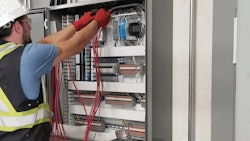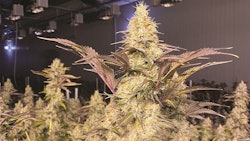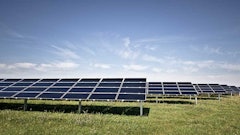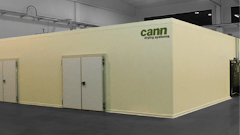
There is a lot of knowledge behind the ways cannabis growers might choose to control lighting, climate, and water management systems. Recipes developed over years of practice inform how these cultivators use lighting systems, the target environmental conditions they maintain in grow rooms, and the mix of nutrients supplied when irrigating their plants.
Cultivators can conduct major building systems’ activities differently depending on what type of cultivation operations and building systems they are utilizing. Some facilities may operate on grower memory, where equipment is manually controlled. Others may use controls systems to monitor and manage their building systems. Innovative growers integrate controls together, orchestrating their building systems in concert with each other.
With systems integration, automation is possible and offers opportunities to improve productivity and reduce labor costs. Eliminating employees walking, turning dials, flipping switches, and managing schedules gives growers more time with plants and data.
Automation can also enhance and ensure plant health and vitality. Control system upgrades can pay for themselves by freeing up growers to scout for pests and diseases that may have gone unnoticed, which can prevent crop loss and increase your facility’s productivity.
Today’s controlled grow operations often have systems operating independently. They often perform well in their own lanes but cannot optimally monitor or control without integrating with other systems. For example, a grow light manufacturer might provide a controller with their light, but their proprietary control system is designed to control their lights alone. Out of the box, their lights cannot automatically dim based on inputs from environmental sensors made by other manufacturers, nor inform HVAC or irrigation processes. This requires the integration of independent systems.
When shopping for integrated systems, it is important that growers seek proposals from several different contractors and engineers in the process, and make sure those proposals include detailed scope of work descriptions so the cultivator will know what to expect from a controls project. Prices for controls systems can vary dramatically depending on the scope of the project, number of systems that need to be integrated, and facility location. It’s crucial the cultivator be very involved with the proposal process to ensure transparency.
Plants and their surrounding environment need to work in harmony for optimized growth. Integrated systems in your facility coordinate their performance to optimize plant production and increase yields.
Connecting Controls
Technology is quickly advancing for indoor farmers, and hardware manufacturers continue to launch independent controllers to support their product lines. Integrated controls systems empower farmers to make system-wide agricultural decisions that reduce labor requirements, increase agricultural yields, maximize resource efficiency, and mitigate risks.
Integration can be complex, requiring the use of a unified controller and monitoring from a single software interface to manage processes in your facility. System integrators unify systems that don’t usually communicate and work together. Their independent software connects systems, gets them to communicate, and controls and automates lighting, climate and airflow, and water management processes.
Partnering with vendors who make it easy to integrate hardware and software can be beneficial to growers. Some vendors choose an open philosophy, while others build closed systems. Vendors with an open business model operate on a transparent and collaborative philosophy, allow for easy integration with their controls and hardware, and do not lock customers into their product lines alone. They build their equipment to enable data integration through open application programming interfaces (APIs) so growers can add their own automated sequences.
On the other hand, vendors with a closed business model force customers to rely exclusively on their products and services and may use “black box” controls that are opaque and cannot be changed by the user. Cultivators can question vendors about their open or closed philosophy and work with those who will make things easier.
The ability to conduct your processes remotely through a unified controller and unified data system within a common user interface can empower your facility with a single software interface and reduce the number of controllers to manage. It also allows operators to benefit from labor reduction costs, mitigate risks associated with the use of multi-control systems, harmonize data across systems, and make data-driven decisions. Operators can implement standard operating procedures using control panels where growers can watch automation at work and fine-tune systems in real-time, such as zone lighting, PAR reading, temperature and humidity control, and irrigation and fan scheduling. Growers today have turned to these solutions to find efficiencies.
“The environment control system we have deployed in one of our dry rooms manages the entire environment from a single ‘brain,’ hence eliminating environment bouncing and providing the ability to set control dependencies between the various monitored parameters,” says Daniel Vlad, CTO of Artizen Cannabis, located in Washington state. “This centralized approach is further enhanced by a well-thought-out user experience design, flexible program configuration, monitoring alert system, mobile access, and the ability to implement controller redundancy. This implementation has helped improve the environment's stability, saved countless hours of management time, and helped save energy."
The Value of Data
The power of leveraging control systems to detect problems, reduce labor, and increase yields lies in the data that control systems produce. Control systems typically contain hundreds of sensors measuring various conditions and collecting data at regular intervals to track historical trends, generating tens of thousands of data points from a cultivation facility every single day. Data examples include actual grow room light levels, temperature and humidity readings, and watering rate.
Harnessing this data to identify useful patterns and outliers provides a grow operation with tremendous insight into its facility and presents opportunities to fine-tune controls to maximize production and efficiency. However, capturing so much data presents issues of its own.
Growers and facilities maintenance personnel are typically not data science experts, and this amount of trended data can quickly become overwhelming and useless for the people it intends to help. Cultivators shouldn’t try to go full bore out of the box because not every data point will be important to their facility. Also, software tools on the market today can relieve the burden of data analysis from the grower. Fault Detection and Diagnostics (FDD) software analyzes data from control systems and presents clear and actionable insights to growers in a user-friendly way. FDD alarms can notify growers of microclimates in their grow rooms, send alerts when actual grow room environmental conditions have been outside of target ranges for too long, and detect malfunctioning components responsible for suboptimal performance. Integrated controls with FDD software can tell growers the real conditions plants are experiencing, flag issues affecting performance, and reduce operational expenses from labor and energy while increasing flower production.
Start Your Journey to Automation
When pursuing automated growing environments, cultivators can consider these benefits and decide which are most important to their business's bottom line.
Monitor Data: Monitoring facilities before moving to control or automate any systems is often beneficial. It’s important to become comfortable with using data and be confident in its accuracy. If growers start controlling first, they are assuming the data is good. By researching how existing equipment and its sequence of operations work, growers can more easily find ways to make them work in harmony.
Cultivation facility operators can use sensors to monitor actual grow room conditions to better understand them and identify areas for improvement more easily. By using that data, operators can prioritize the systems they automate first. How will the control philosophy evolve? Which systems will be monitored, and which will be controlled?
Detect Problems: Most control systems generate alarms when certain conditions are out of range. However, cultivation facilities rely on precise control, and, too often, alarms sound when it is too late and issues have become an emergency. Analytics software detects problems in the system well before reaching an emergency alarm state by searching for patterns in control system data and alerting the user when conditions begin slipping away from the norm. Growers can take action by using their FDD software’s recommended resolutions to fix issues.
Reduce Labor: Control systems allow facilities personnel to be more efficient with their time. A well-built integrated controls system with analytics software reduces the amount of time a cultivator spends managing environmental conditions and identifying issues in a facility. Cannabis facility operators should have a dedicated facility manager on staff to perform preventative maintenance, troubleshoot issues, and allow growers to focus on what they do best: grow plants.
Operators should focus the facility’s personnel and contractors on what is underperforming in the systems to optimize performance and detect slips in performance before issues become too large. As with most things, correcting a minor performance issue will be easier to manage than fixing a catastrophic failure (and will cost less).
Increase Yields: Cultivation facilities with a high amount of integration can leverage analytics to increase production yields. When production and chemistry data are integrated into analytics software and paired with environmental, lighting, and irrigation data, growers can become empowered to explore ways of tweaking facility performance to optimize yields. Measuring changes in environmental conditions and correlating that data to yield is a powerful way to leverage control system data for increased crop production.
Integrated controls systems and analytics software can help a cultivator, no matter the size of the grow facility. Often the most successful projects start simply with just a few data points. Over time, the analytics software is built up through interaction between cultivators and service providers. Through curiosity and insight provided by automation and fault detection, cannabis cultivators can grow their controls strategy, benefit from analytics, and reap a more productive harvest.























